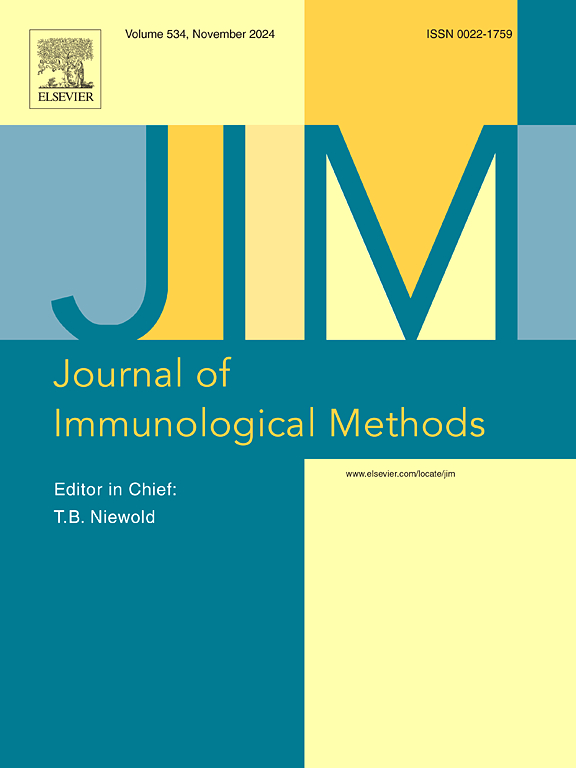验证抗原特异性 B 细胞免疫斑点测定的理论和实践考虑因素。
IF 1.6
4区 医学
Q4 BIOCHEMICAL RESEARCH METHODS
引用次数: 0
摘要
由于它们能够可靠地检测细胞分离物中非常罕见的抗原特异性B细胞,如外周血单个核细胞(PBMC),并且以高通量兼容的方式稳健地进行检测,B细胞ELISPOT/FluoroSpot(统称为“B细胞免疫点”)测试在受调节的环境中对免疫监测越来越有吸引力。目前,对于B细胞免疫斑点测定结果的鉴定和验证尚无指导方针。在这里,我们提出这样的指导方针,基于从T细胞免疫点测试中获得的经验,在遵守监管机构要求的环境中,同时考虑到B细胞检测的独特性。提出了一种简化的方案,允许在三个实验中进行抗原特异性B细胞免疫斑点测定的正式验证所需的所有测试,每个供体利用2.2 × 107 PBMC。随后,每个样品仅利用1-2 × 106 PBMC(可从1至2 mL血液中获得),经过验证的多路分析能够准确定量抗原特异性记忆B细胞衍生的原细胞分泌IgM, IgG, IgA或IgE抗体的频率。总的来说,这种多路B细胞免疫点检测方法为B细胞免疫监测程序提供了巨大的价值,因为它们易于实施,可扩展性,基本上适用于任何抗原系统,PBMC利用的经济性,最后但并非最不重要的是,获得了高含量的信息。本文章由计算机程序翻译,如有差异,请以英文原文为准。
Theoretical and practical considerations for validating antigen-specific B cell ImmunoSpot assays
Owing to their ability to reliably detect even very rare antigen-specific B cells in cellular isolates such as peripheral blood mononuclear cells (PBMC), and doing so robustly in a high throughput-compatible manner, B cell ELISPOT/FluoroSpot (collectively “B cell ImmunoSpot”) tests have become increasingly attractive for immune monitoring in regulated settings. Presently, there are no guidelines for the qualification and validation of B cell ImmunoSpot assay results. Here, we propose such guidelines, building on the experience acquired from T cell ImmunoSpot testing in an environment adhering to the requirements of regulatory bodies yet taking the unique features of B cell assays into account. A streamlined protocol is proposed that permits the performance of all tests needed for the formal validation of an antigen-specific B cell ImmunoSpot assay in only three experiments, utilizing 2.2 × 107 PBMC per donor. Subsequently, utilizing only 1–2 × 106 PBMC per sample (obtainable from 1 to 2 mL of blood), a validated multiplexed assay enables accurate quantification of the frequency of antigen-specific memory B cell-derived blasts secreting IgM, IgG, IgA or IgE antibodies. Collectively, such multiplexed B cell ImmunoSpot assays offer immense value for B cell immune monitoring programs due to their ease of implementation, scalability, applicability to essentially any antigenic system, economy of PBMC utilization, and last but not least, the high content information gained.
求助全文
通过发布文献求助,成功后即可免费获取论文全文。
去求助
来源期刊
CiteScore
4.10
自引率
0.00%
发文量
120
审稿时长
3 months
期刊介绍:
The Journal of Immunological Methods is devoted to covering techniques for: (1) Quantitating and detecting antibodies and/or antigens. (2) Purifying immunoglobulins, lymphokines and other molecules of the immune system. (3) Isolating antigens and other substances important in immunological processes. (4) Labelling antigens and antibodies. (5) Localizing antigens and/or antibodies in tissues and cells. (6) Detecting, and fractionating immunocompetent cells. (7) Assaying for cellular immunity. (8) Documenting cell-cell interactions. (9) Initiating immunity and unresponsiveness. (10) Transplanting tissues. (11) Studying items closely related to immunity such as complement, reticuloendothelial system and others. (12) Molecular techniques for studying immune cells and their receptors. (13) Imaging of the immune system. (14) Methods for production or their fragments in eukaryotic and prokaryotic cells.
In addition the journal will publish articles on novel methods for analysing the organization, structure and expression of genes for immunologically important molecules such as immunoglobulins, T cell receptors and accessory molecules involved in antigen recognition, processing and presentation. Submitted full length manuscripts should describe new methods of broad applicability to immunology and not simply the application of an established method to a particular substance - although papers describing such applications may be considered for publication as a short Technical Note. Review articles will also be published by the Journal of Immunological Methods. In general these manuscripts are by solicitation however anyone interested in submitting a review can contact the Reviews Editor and provide an outline of the proposed review.

 求助内容:
求助内容: 应助结果提醒方式:
应助结果提醒方式:


